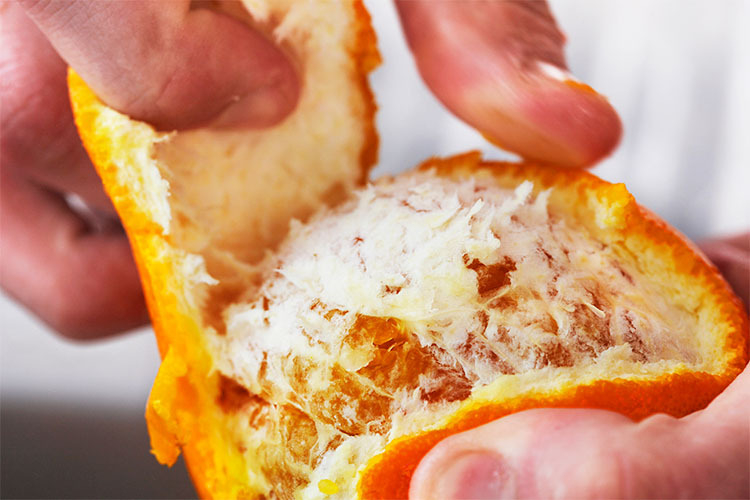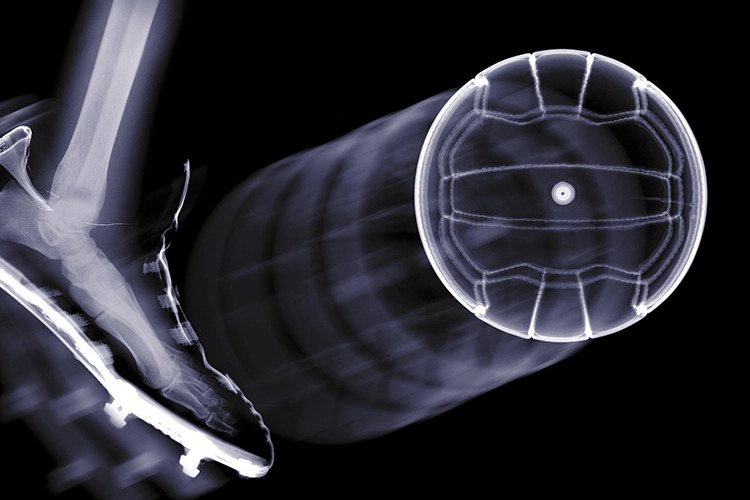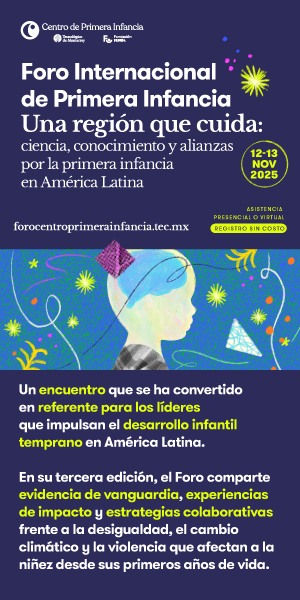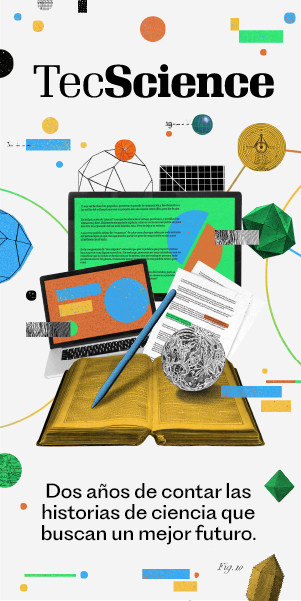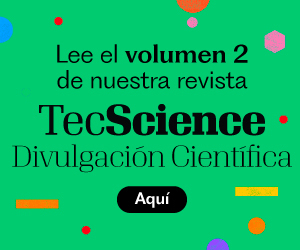By Liv Vlaminck Hernández and Romina F. Steele | AMATEUR SCIENCE
Reviewed by Jorge Welti Chanes and Magdalena de Jesús Rostro Alanís
Each year, Mexico generates nearly 800,000 tons of citrus waste, most of which is discarded untreated. This not only causes significant pollution but also results in the loss of valuable compounds such as pectin, fibers, and essential oils [1, 2].
This situation represents not just an environmental loss but also a missed opportunity for innovation and sustainability.
An orange peel consists of two layers: the outer layer, called the flavedo, is the orange-colored part that contains essential oils—yes, the ones responsible for the fruit’s distinctive aroma.
The inner layer, known as the albedo, has a yellowish tone [3]. This is where we find pectin, an organic molecule highly valued by the food and pharmaceutical industries. Pectin gives jam its familiar thickness and contributes to the texture of many popular baked goods [1, 4–7].
In the pharmaceutical industry, pectin is especially prized for its ability to form gels and increase the viscosity of syrups, capsules, and suspensions—helping keep active ingredients evenly distributed. It also enables the design of controlled-release drug delivery systems that protect active compounds until they reach their target sites.
As a soluble fiber, pectin offers additional health benefits: it helps lower blood cholesterol and glucose levels, and its biocompatibility and safety make it an ideal component for various medicinal formulations.
Pectin Extraction Methods
Pectin is found in the cell walls of all plants, which are composed of a complex network of hemicellulose, cellulose, and pectin [1, 8].
Currently, pectin extraction is carried out using unsustainable methods. One common approach relies on mineral acids, such as hydrochloric acid, a highly polluting solvent that—when released into the environment —contributes to the acidification of ecosystems [1, 9].
Using these compounds for pectin extraction completely defeats the purpose of making responsible use of waste materials. To address this challenge, researchers have been developing more environmentally friendly alternatives.
For instance, recent studies have proposed using citric acid—a greener solvent compared to traditional acids [1, 10]. This approach could help make pectin extraction practices more sustainable, while also improving both the process and the quality of the pectin obtained.
Another promising alternative involves using enzymes that break down hemicellulose and cellulose in the peel’s cell walls to release the compound of interest: pectin. Enzymes such as cellulase and xylanase act as biocatalysts that hydrolyze non-pectic components, degrading the cell wall and facilitating pectin release [1, 11].
From Peels to Pectin
Our study, “Conventional and Innovative Methods for Pectin Extraction from Agro-industrial By-products,” published in Food Engineering Reviews, highlights the potential of orange peels as an efficient source of high-quality pectin and emphasizes the importance of valorizing agricultural by-products.
The results demonstrate the effectiveness of enzymatic and citric acid extraction methods for obtaining pectin from citrus peels, showing significant advantages over traditional techniques that rely on mineral acids, such as hydrochloric acid.
The higher yields and favorable chemical properties of the extracted pectin suggest that enzymatic or less corrosive organic acid processes can meet the growing demand for sustainable, high-quality food additives. Optimizing extraction conditions and using agricultural residues not only helps reduce waste but also improves the economic viability of pectin production.
These advances contribute to sustainability by employing two green and innovative techniques in pectin research: enzymatic extraction and citric acid extraction. Both methods maximize the value of agricultural by-products, promote waste reduction, and support the principles of a circular economy.
So far, these approaches have not only successfully extracted the target compound but also produced high-quality pectin in greater quantities compared to conventional methods.
These breakthroughs are not just laboratory achievements—they are proof that Mexico has the potential to transform its agricultural waste into engines of innovation and sustainability. A country where orange peels are no longer trash but the starting point for a greener, more competitive economy.
References
- Macias-Frotto, B., Rostro-Alanís, M., Escobedo-Avellaneda, Z., & Welti-Chanes, J. (2024). Conventional and Innovative Methods for Pectin Extraction from Agro-industrial By-products. Food Engineering Reviews.
- Galindo-Segura, L. A., Pérez-Vázquez, A., Ramírez-Martínez, A., López-Romero, G., & Gómez-Merino, F. C. (2023). El Manejo del Bagazo de Naranja en la Zona Centro del Estado de Veracruz. Terra Latinoamericana, 41.
- Jentzsch, M., Albiez, V., Kardamakis, T. C., & Speck, T. (2024b). Analysis of the peel structure of different Citrus spp. via light microscopy, SEM and µCT with manual and automatic segmentation. Soft Matter.
- [4] Cortés-Camargo, S., Román-Guerrero, A., Alpizar-Reyes, E., & Pérez-Alonso, C. (2023). New Sources of Pectin: Extraction, Processing, and Industrial Applications. En IntechOpen eBooks.
- Garcia-Amezquita, L. E., Tejada-Ortigoza, V. A., Pérez-Carrillo, E., Serna-Saldívar, S. O., Campanella, O. H., & Welti-Chanes, J. (2019). Functional and compositional changes of orange peel fiber thermally-treated in a twin extruder. LWT – Food Science and Technology, 111, 673–681.
- Tejada-Ortigoza, V. A., Garcia-Amezquita, L. E., Serna-Saldívar, S. O., Martín-Belloso, O., & Welti-Chanes, J. (2018). High hydrostatic pressure and mild heat treatments for the modification of orange peel dietary fiber: Effects on hygroscopic properties and functionality. Food and Bioprocess Technology, 11, 110–121.
- Donchenko, L. V., Sokol, N. V., Sanzharovskaya, N. S., Khrapko, O. P., & Mikhaylova, T. A. (2020). Functional role of pectin in the bakery technology. IOP Conference Series Earth and Environmental Science, 488(1), 012010.
- Roman-Benn, A., Contador, C. A., Li, M., Lam, H., Ah-Hen, K., Ulloa, P. E., & Ravanal, M. C. (2023). Pectin: An overview of sources, extraction and applications in food products, biomedical, pharmaceutical and environmental issues. Food Chemistry Advances, 2, 100192.
- Chandel, V., Biswas, D., Roy, S., Vaidya, D., Verma, A., & Gupta, A. (2022). Current Advancements in Pectin: Extraction, Properties and Multifunctional Applications. Foods, 11(17), 2683.
- Dranca, F., & Oroian, M. (2018). Extraction, purification and characterization of pectin from alternative sources with potential technological applications. Food Research International, 113, 327-350.
- Riyamol, N., Chengaiyan, J. G., Rana, S. S., Ahmad, F., Haque, S., & Capanoglu, E. (2023). Recent Advances in the Extraction of Pectin from Various Sources and Industrial Applications. ACS Omega, 8(49), 46309-46324.
.
Authors
Liv Vlaminck Hernández – Biotechnology Engineering student. She has participated in research projects through the U-LEAD program. Her experience includes valorizing agricultural by-products and synthesizing monomers for sustainable material development. She also contributed to Expo Ingenierías with an innovative plant tissue culture project. Her academic focus is on integrating biotechnology and the circular economy to design eco-friendly technologies and promote sustainability.
Romina F. Steele – Biotechnology Engineering student at Tecnológico de Monterrey. She has been involved in science outreach projects as an assistant and editor for publications, such as Arte, Cultura y Sociedad, and Revista Youth Science. She has also participated in science promotion events, such as the Ascendion Science Fair and Expo Ciencias, and collaborated with the university’s iGEM team, developing a sustainability- and environment-focused project for an international molecular biology competition.
This article was supervised by:
Jorge Welti Chanes – Project leader for Food Security & Nutrition at the Health Research Hub of the School of Engineering and Sciences, Tecnológico de Monterrey. He is a research professor with over 45 years of experience and a member of the National System of Researchers.
Magdalena Rostro Alanís – Researcher at the School of Engineering and Sciences, Tecnológico de Monterrey, with 10 years of experience. She is also a member of the National System of Researchers
